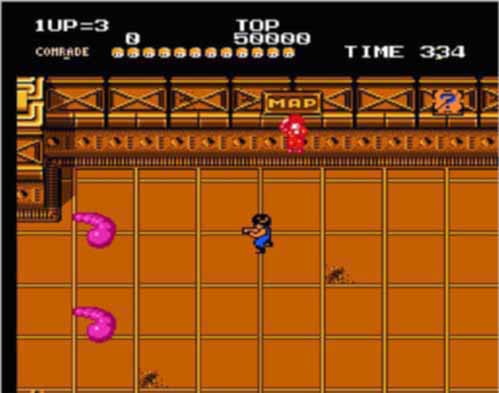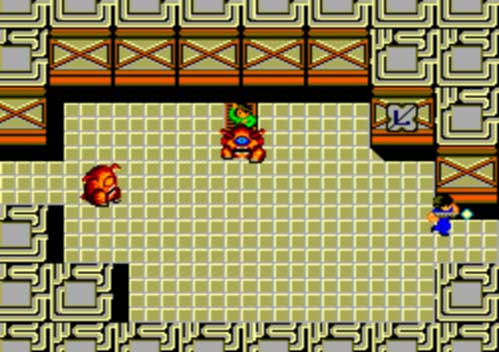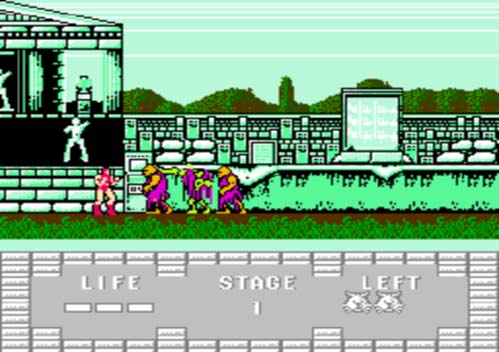Sega Master System vs Nintendo Entertainment System
| Lifespan: | 1986-1992 | |
|---|---|---|
| CPU: | 3.58 MHz Z80 | |
| Audio: | 4 Channels 3 | |
| Co-Processor: | VDP | |
| Resolutions: | 256x192, 256x224, 256x240 (PAL) 4 | |
| RAM: | 8KB | |
| Video RAM: | 16KB | |
| Color RAM: | 32 bytes5 | |
| Colors On Screen: | 32 (two 16-color palettes)6 |
|
| Color Palette: | 64 | |
| Sprite Max & Size: | 64 at 8x8, 8x16, 16x16, 16x327 |
|
| Sprites per Scanline: | 8 8 | |
| Storage: | Sega Card (32KB) Cartridge 1Mb - 4 Mbit |
 9 10
9 10
| Lifespan: | 1986-199211 |
|---|---|
| CPU: | 1.79 MHz 6502 |
| Audio: | 5 Channels 12 13 |
| Co-Processors: | PPU, pAPU14, MMC15 |
| Resolution: | 256x224 visible of 256x24016 |
| RAM: | 2KB |
| Video RAM: | 2KB |
| Colors On Screen: | 16 (four 4-color background palettes + four 4-color sprite palettes)17 |
| Color Palette: | 52 |
| Sprite Max & Size: | 64 at 8x8 and 8x16 |
| Sprites per Scanline: | 8 18 |
| Storage: | Cartridge 1 Mbit - 4 Mbit Average: 1 Mbit |
Hardware specifications for the 8-bit consoles (1982-1987) are relatively easy to read. The Sega Master System arguably trumped the Nintendo Entertainment System in most technical respects, aside from the base systems' audio capabilities. Both systems were also released nation wide in the United States in 1986.19 Yet technical superiority affects the market success of a console very little. Size and quality of a game console's library might be given lip service in comments and editorials, but games tend to play second fiddle to popularity and brand over the history of the game industry.
Third party developer (third party) support for the Sega Master System (SMS) was comparatively small due to the monopoly Nintendo designed for the Nintendo Entertainment System (NES). Licensing contracts for the NES prevented third parties from making the same game on other consoles for two years.20 This fact was exacerbated by Nintendo's publishing empire in Japan, where most of the world's game developers and publishers survived the "crash" of 1984. Nintendo's affinity for legal recourse locked most third parties into sitting on their Intellectual Property (IP) or rebranding and selling it to other console manufacturers.
 Nintendo's stringent publishing controls left them with less than ten third parties in 1986.21 While Nintendo was courting third party developers and establishing its dominance at retail in 198722, Sega was adapting its significantly larger arcade catalog to the SMS.23 As a result, the NES library only clearly surpassed its main rival console in quantity of quality titles after the 16-bit generation was in its stride in 1990.24
Nintendo's stringent publishing controls left them with less than ten third parties in 1986.21 While Nintendo was courting third party developers and establishing its dominance at retail in 198722, Sega was adapting its significantly larger arcade catalog to the SMS.23 As a result, the NES library only clearly surpassed its main rival console in quantity of quality titles after the 16-bit generation was in its stride in 1990.24
Sega's Master System is home to a number of exclusive titles, including the first console role playing games in the West. Phantasy Star and Miracle Warriors included innovative features such as animated 3D dungeons, five save anywhere save slots, female protagonists, diverse monster designs, and complex clue based puzzles. For every space ship shooter, "Mario" platformer or "Zelda" adventure game on the NES, the Master System had an exclusive with at least equal gameplay quality and better graphics. Yet the total US release list only added up to one hundred and fourteen titles, most of which were published, if not originally designed or recoded, by Sega themselves.
A controversial difference exists between companies like Sega and companies like Capcom, Nintendo, and Namco during these formative years of the game industry. Sega's focus on games throughout their time as a hardware manufacturer was focused on creating unique experiences and advancing the technology. Nearly all of Nintendo's mainline publishers, and Nintendo themselves, focused on creating popular game franchises. Exceptions to this rule exist on both sides, but the principle is dominant in the published software. What this means to the history of gaming is that a monumental battle occurred in game development theory immediately upon the arrival of Japan in the US game industry. Conceptually, the question these companies' games present is whether the consumer wanted unique experiences in high quantity and quality, or whether they wanted familiar experiences to be replicated. Game developers in this era, perhaps unconsciously, asked whether consumers wanted to try something new more frequently than they wanted to play the third, fourth or fifth iteration of essentially the same game.
In addition to exclusive unique games, a very notable peripheral was only released for the SMS, Liquid Crystal Display 3D glasses. These glasses plugged in to the secondary game card slot on the SMS, and synchronized opaque flashes on either eye with flashing character sprites on the television. The resulting effect produced a 3D effect far superior to red and blue card board glasses and is a technical marvel that is supposed to revolutionize television and movies in the new millennium.
A relatively short library includes Blade Eagle 3D, Maze Hunter 3D, Missile Defense 3D, Space Harrier 3D, Poseidon Wars 3D, Zaxxon 3D, and the Euro only release of Outrun 3D sum up the relatively small library of 3D games for the Master System. So unique were these glasses that Sega even included them as a pack in for the more expensive Master System console package. Notable as this peripheral was, what few consumers actually bought an SMS gravitated toward cheaper packages.
Despite these very notable facts, the Sega Master System was a total marketing failure for Sega in Japan and the United States. To its credit, the SMS actually dominated well into the mid 90's in Europe, Australia, New Zealand and Brazil, and revenue generated from these countries has caused a great deal of games to be produced. Many more Master System games were made for these markets that are actually compatible without modification with US Master Systems. Were there a sizeable retro-gaming market in the early 2000s, this too would be a notable fact about the Master System.
There are popular theories as to why the SMS was not a success in the United States. One very plausible reason is Nintendo's monopolistic licensing contracts with third parties. This left the SMS without popular third party titles available on a large enough scale to compete with the NES library. Another contributing factor was Sega's lack of a United States office at the time of the Master System's release. Sega sold the publishing and marketing rights to Tonka toys because Tonka had more resources to make the system a success. Unfortunately, the presentation by numerous sources is that Tonka sat on the Master System until their multi-year contract with Sega was up. This presentation is no doubt inaccurate to the reality of Nintendo's strangle hold on retailers from 1987 onward.
Facts state the case much more concisely. With relatively insignificant marketing, and the fact that Nintendo ensured that the console itself was not available on as many shelves as the NES, the Master System was actually doomed from the moment it landed on US shores. Well documented defects in the NES's quality control and design, which has caused up to 30% of systems shipped to stop playing games and all games to have noticeable glitching during scrolling scenes, were utterly overlooked by consumers.
The NES and SMS were Nintendo's and Sega's first entries in the video game console market in the United States. Nintendo and a group of less than ten third party developers helped to propel the NES to monumental success by 1988. Sega and a handful of other third parties supported the Master System with exclusive arcade and home-only game software, adding up to one hundred and fourteen titles. The Nintendo Entertainment System sold something around fifty million worldwide and saw seven hundred and sixty-one releases in the United States. Thirteen Million SMSs were sold worldwide from 1985-1998, and US support for the console was cut off around 1992.
In regard to what people were actually playing on each system, according to reviews online, over one hundred of the final US SMS library have been noted as having unique or highly polished gameplay, in such a way that they have received a recommendation from reviewers today. By comparison, roughly three hundred of the NES's final library of over seven hundred and sixty titles have been recommended for similar reasons. From 1986-1988, the SMS and NES had roughly the same number of titles which people have found worth mentioning. The majority of the NES's vastly larger library, and its lead in notable game titles, was gained after 1989, when the 16-bit era had already begun and the NES was the only mass market 8-bit platform.
- 1. Legacy Sega Consoles: Sega Master System, Sega of America (archive.org January 19, 2002).
- 2. Samuel N. Hart, A Brief History of Home Video Games: Side-by-side Comparison of the Sega Master System and Nintendo Entertainment System, Geek Comix (archive.org June 25, 2008).
- 3. 3 channel tone generator, white noise channel, mono Super Majik Spiral Crew's Guide to the Sega Master System (0.02) (smsc.txt) Basic Sound (Public Domain, SMSC, June 21, 1997, accessed March 11, 2010) available from http://emudocs.org/?page=Master%20System; internet.
- 4. Charles MacDonald, E-mail || Homepage, Sega Master System VDP documentation (msvdp.txt), 11.) Display timing (2002, accessed March 11, 2010) available from http://emudocs.org/?page=Master%20System; internet.
- 5. MacDonald, msvdp.txt, 5.) Color RAM.
- 6. Background patterns can use either palette, while sprite patterns can only use the second one. MacDonald, msvdp.txt, 5.) Color RAM.
- 7. 16x16 and 16x32 Sprites are only available when all sprites on screen are stretched, smsc.txt,
Register 81h.
- 8. msvdp.txt 10.) Sprites.
- 9. Hart, Side-by-side Comparison of the Sega Master System and Nintendo Entertainment System.
- 10. Nintendo of America, Systems: NES Specifications (archive.org June 15, 2001).
- 11. NES was test marketed in 500 to 600 retail stores in New York during Christmas, 1985, David Sheff, Game Over: How Nintendo Zapped an American Industry, Captured Your Dollars, and Enslaved Your Children (New York: Random House, 1993), 169.
- 12. 2 Square Waves, 1 Triangle, 1 White Noise, 1 Delta Modulation Channel for samples, Uses the CPU. Brad Taylor, The NES sound channel guide 1.8 (nessound.txt), Introduction (July 27, 2000, accessed March 11, 2010) available from http://emudocs.org/?page=NES; internet.
- 13. Brad Taylor, NTSC delta modulation channel documentation 2nd release (DMC.txt), (February 19, 2003, accessed July 17, 2011) available from http://nesdev.parodius.com/dmc.txt; internet.
- 14. "virtual" sound unit inside CPU
- 15. Yoshi, Nintendo Entertainment System Documentation 2.0 (nestech.txt), 2. Acronyms (accessed March 11, 2010) available from http://emudocs.org/?page=NES; internet.
- 16. Martin Korth, Everynes - Nocash NES Specs (everynes.txt) PPU Dimensions & Timings (2004, accessed March 11, 2010) available from http://emudocs.org/?page=NES; internet.
- 17. everynes.txt PPU Palettes.
- 18. everynes.txt PPU Sprites.
- 19. Steven L. Kent, The Ultimate History of Video Games (New York: Three Rivers Press, 2001), 303.
- 20. Sheff, Game Over, 215.
- 21. Kent, The Ultimate History of Video Games, 307.
- 22. Sheff, Game Over, 171.
- 23. Kent, The Ultimate History of Video Games, 304.
- 24. Notable Games: 1985-1990, http://www.gamepilgrimage.com.




